
A subwoofer is a loudspeaker designed to reproduce low-pitched audio frequencies known as bass and sub-bass, lower in frequency than those which can be (optimally) generated by a woofer. The typical frequency range for a subwoofer is about 20–200 Hz for consumer products, below 100 Hz for professional live sound, and below 80 Hz in THX-certified systems. Subwoofers are never used alone, as they are intended to augment the low-frequency range of loudspeakers that cover the higher frequency bands. While the term "subwoofer" technically only refers to the speaker driver, in common parlance, the term often refers to a subwoofer driver mounted in a speaker enclosure (cabinet), often with a built-in amplifier.

A loudspeaker is an electroacoustic transducer, that is, a device that converts an electrical audio signal into a corresponding sound. A speaker system, also often simply referred to as a "speaker" or "loudspeaker", comprises one or more such speaker drivers, an enclosure, and electrical connections possibly including a crossover network. The speaker driver can be viewed as a linear motor attached to a diaphragm which couples that motor's movement to motion of air, that is, sound. An audio signal, typically from a microphone, recording, or radio broadcast, is amplified electronically to a power level capable of driving that motor in order to reproduce the sound corresponding to the original unamplified electronic signal. This is thus the opposite function to the microphone, and indeed the dynamic speaker driver, by far the most common type, is a linear motor in the same basic configuration as the dynamic microphone which uses such a motor in reverse, as a generator.

Home cinema, also called home theaters or theater rooms, are home entertainment audio-visual systems that seek to reproduce a movie theater experience and mood using consumer electronics-grade video and audio equipment that is set up in a room or backyard of a private home. Some studies show films are rated better and generate more intense emotions when watched in a movie theater, however, convenience is a major appeal for home cinemas. In the 1980s, home cinemas typically consisted of a movie pre-recorded on a LaserDisc or VHS tape; a LaserDisc or VHS player; and a heavy, bulky large-screen cathode ray tube TV set, although sometimes CRT projectors were used instead. In the 2000s, technological innovations in sound systems, video player equipment and TV screens and video projectors have changed the equipment used in home cinema set-ups and enabled home users to experience a higher-resolution screen image, improved sound quality and components that offer users more options. The development of Internet-based subscription services means that 2016-era home theatre users do not have to commute to a video rental store as was common in the 1980s and 1990s
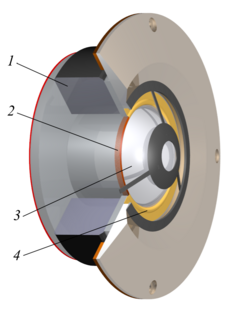
A tweeter or treble speaker is a special type of loudspeaker that is designed to produce high audio frequencies, typically deliver high frequencies up to 100 kHz. The name is derived from the high pitched sounds made by some birds (Tweets), especially in contrast to the low woofs made by many dogs, after which low-frequency drivers are named (woofers).

A mid-range speaker is a loudspeaker driver that reproduces sound in the frequency range from 250 to 20000 Hz. It is also known as a squawker.
A woofer or bass speaker is a technical term for a loudspeaker driver designed to produce low frequency sounds, typically from 50 Hz up to 1000 Hz. The name is from the onomatopoeic English word for a dog's bark, "woof". The most common design for a woofer is the electrodynamic driver, which typically uses a stiff paper cone, driven by a voice coil surrounded by a magnetic field.
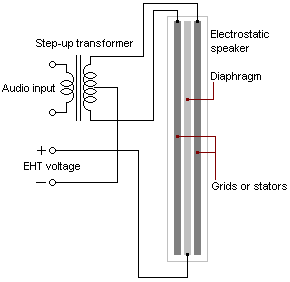
An electrostatic loudspeaker (ESL) is a loudspeaker design in which sound is generated by the force exerted on a membrane suspended in an electrostatic field.
Henry Kloss was a prominent American audio engineer and entrepreneur who helped advance high fidelity loudspeaker and radio receiver technology beginning in the 1950s. Kloss was an undergraduate student in physics at the Massachusetts Institute of Technology, but never received a degree. He was responsible for a number of innovations, including, in part, the acoustic suspension loudspeaker and the high fidelity cassette deck. In 2000, Kloss was one of the first inductees into the Consumer Electronics Association's Hall of Fame. He earned an Emmy Award for his development of a projection television system, the Advent VideoBeam 1000.

A bass reflex system is a type of loudspeaker enclosure that uses a port (hole) or vent cut into the cabinet and a section of tubing or pipe affixed to the port. This port enables the sound from the rear side of the diaphragm to increase the efficiency of the system at low frequencies as compared to a typical sealed- or closed-box loudspeaker or an infinite baffle mounting.
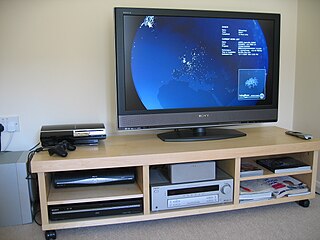
An entertainment center, also known as an entertainment complex, is a piece of furniture designed to house consumer electronic appliances and components, such as televisions.

Powered speakers, also known as self-powered speakers and active speakers, are loudspeakers that have built-in amplifiers. Powered speakers are used in a range of settings, including in sound reinforcement systems, both for the main speakers facing the audience and the monitor speakers facing the performers; by DJs performing at dance events and raves; in private homes as part of hi-fi or home cinema audio systems and as computer speakers. They can be connected directly to a mixing console or other low-level audio signal source without the need for an external amplifier. Some active speakers designed for sound reinforcement system use have an onboard mixing console and microphone preamplifier, which enables microphones to be connected directly to the speaker.

Acoustic Research was a Cambridge, Massachusetts-based company that manufactured high-end audio equipment. The brand is now owned by VOXX. Acoustic Research was known for the AR-3 series of speaker systems, which used the 12 in (300 mm) acoustic suspension woofer of the AR-1 with newly designed dome mid-range speaker and high-frequency drivers. AR's line of acoustic suspension speakers were the first loudspeakers with relatively flat response, extended bass, wide dispersion, small size, and reasonable cost.
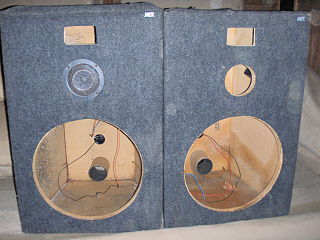
A loudspeaker enclosure or loudspeaker cabinet is an enclosure in which speaker drivers and associated electronic hardware, such as crossover circuits and, in some cases, power amplifiers, are mounted. Enclosures may range in design from simple, homemade DIY rectangular particleboard boxes to very complex, expensive computer-designed hi-fi cabinets that incorporate composite materials, internal baffles, horns, bass reflex ports and acoustic insulation. Loudspeaker enclosures range in size from small "bookshelf" speaker cabinets with 4" woofers and small tweeters designed for listening to music with a hi-fi system in a private home to huge, heavy subwoofer enclosures with multiple 18" or even 21" speakers in huge enclosures which are designed for use in stadium concert sound reinforcement systems for rock music concerts.
The Isobaric loudspeaker configuration was first introduced by Harry F. Olson in the early 1950s, and refers to systems in which two or more identical woofers operate simultaneously, with a common body of enclosed air adjoining one side of each diaphragm. In practical applications, they are most often used to improve low-end frequency response without increasing cabinet size, though at the expense of cost and weight.

A speaker enclosure using a passive radiator (PR) usually contains an "active loudspeaker", and a passive radiator. The active loudspeaker is a normal driver, and the passive radiator is of similar construction, but without a voice coil and magnet assembly. It is not attached to a voice coil or wired to an electrical circuit or power amplifier. Small and Hurlburt have published the results of research into the analysis and design of passive-radiator loudspeaker systems. The passive-radiator principle was identified as being particularly useful in compact systems where vent realization is difficult or impossible, but it can also be applied satisfactorily to larger systems.
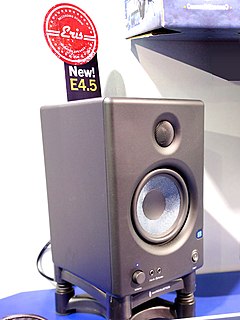
Studio monitors are loudspeakers in speaker enclosures specifically designed for professional audio production applications, such as recording studios, filmmaking, television studios, radio studios and project or home studios, where accurate audio reproduction is crucial. Among audio engineers, the term monitor implies that the speaker is designed to produce relatively flat (linear) phase and frequency responses. In other words, it exhibits minimal emphasis or de-emphasis of particular frequencies, the loudspeaker gives an accurate reproduction of the tonal qualities of the source audio, and there will be no relative phase shift of particular frequencies—meaning no distortion in sound-stage perspective for stereo recordings. Beyond stereo sound-stage requirements, a linear phase response helps impulse response remain true to source without encountering "smearing". An unqualified reference to a monitor often refers to a near-field design. This is a speaker small enough to sit on a stand or desk in proximity to the listener, so that most of the sound that the listener hears is coming directly from the speaker, rather than reflecting off of walls and ceilings. Monitor speakers may include more than one type of driver or, for monitoring low-frequency sounds, such as bass drum, additional subwoofer cabinets may be used.

Bi-amping and tri-amping is the practice of using two or three audio amplifiers to amplify different audio frequency ranges, with the amplified signals being routed to different speaker drivers, such as woofers, subwoofers and tweeters. Biamping can be done with a single power amplifier if the device has more than one amplifier, as the case with a stereo power amp. Triamping cannot be done with a stereo power amp; a mono power amp would need to be added or a home theatre receiver could be used. With bi-amping and tri-amping, an audio crossover is used to divide a sound signal into different frequency ranges, each of which is then separately amplified and routed to separate loudspeaker drivers. In some bass amplifiers using bi-amping, the woofer and horn-loaded tweeter are in the same speaker enclosure. In some bi-amp set-ups, the drivers are in separate speaker enclosures, such as with home stereos that contain two speakers and a separate subwoofer.
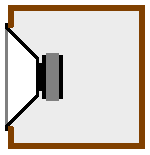
Acoustic suspension is a method of loudspeaker cabinet design and utilisation that uses one or more loudspeaker drivers mounted in a sealed box or cabinet. Acoustic suspension systems reduce bass distortion that can be caused by stiff motor suspensions in conventional loudspeakers. Acoustic suspension was invented in 1954 by Edgar Villchur, and brought to commercial production by Villchur and Henry Kloss with the founding of Acoustic Research in Cambridge, Massachusetts. Speaker cabinets with acoustic suspension can provide well controlled bass response, especially in comparison with an equivalently-sized speaker enclosure that has a bass reflex port or vent. The bass vent boosts low-end output, but at the tradeoff of introducing phase delay and accuracy problems. Sealed boxes are generally less efficient than a reflex cabinet, so a sealed box speaker cabinet will need more electrical power to deliver the same amount of acoustic bass output.
Edgar Marion Villchur was an American inventor, educator, and writer widely known for his 1954 invention of the acoustic suspension loudspeaker which revolutionized the field of high-fidelity equipment. A speaker Villchur developed, the AR-3, is exhibited at The Smithsonian Institution's Information Age Exhibit in Washington, DC.
A soundbar, sound bar or media bar is a type of loudspeaker that projects audio from a wide enclosure. It is much wider than it is tall, partly for acoustic reasons, and partly so it can be mounted above or below a display device. In a soundbar, multiple speakers are placed in a single cabinet, which helps to create stereo sound or a surround-sound effect. A separate subwoofer is typically included with, or may be used to supplement, a soundbar.















